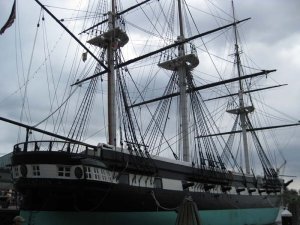Advertisement

 USS Constellation
USS Constellation
The USS Constellation is the last all-sail warship built by the US Navy. It was launched in 1854 out of Portsmouth, Virginia, and though her first duties were largely diplomatic, she helped fight the slave trade, fought in the Civil War, acted as a training ship at the Naval Acadamy in Annapolis, Maryland, and served as the flagship of the US Atlantic Fleet in WWII. Located a short distance from each other, the Maritime Museum in Baltimore's Inner Harbor and the Baltimore & Ohio (B&O) Railroad Museum make for a fantastic day-trip into Baltimore. With family in town, we ventured north for the day, first visiting the B&O Railroad Museum, which is the birthplace of American Railroading and a massive museum of over 40 acres with nearly 200 trains on display.
Then we headed over to Baltimore's Inner Harbor to explore the Maritime Museum, which really means we boarded and explored three ships and a submarine berthed at the Inner Harbor. First there was the USS Constellation, the last all-sail warship built by the US Navy, then the Lightship Chesapeake, which served in the US Lighthouse Service, the USCGC (U.S. Coast Guard Cutter) Taney, the last surviving warship still afloat from WWII, and finally the USS Torsk, a submarine that served in WWII.
I've added most of the descriptions of the trains and ships directly to the photograph captions, to make it easier to identify which is which. Both museums were well worth a visit, especially for kids...though us adults were pretty excited about them, too.
Advertisement
Tot: 0.072s; Tpl: 0.011s; cc: 10; qc: 33; dbt: 0.0402s; 1; m:domysql w:travelblog (10.17.0.13); sld: 1;
; mem: 1mb

 USS Constellation
USS Constellation


















